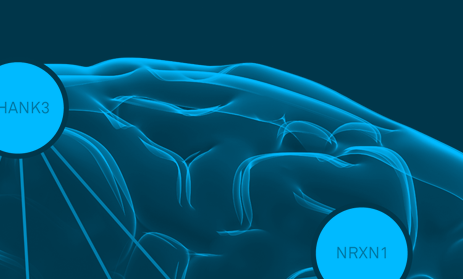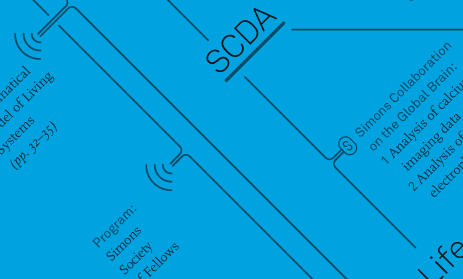What differentiates ‘systems biology’ — the discipline that Richard Bonneau’s research group at SCDA specializes in — from other types of biological study? All biologists consider the cell to be the basic unit of life, but every living cell also contains an immense amount of molecular machinery of its own, which biologists were unable to model in detail before the advent of modern genomic technology. “Genomics is like getting the parts list and seeing what the parts are doing at any given moment,” Bonneau explains, “and systems biology is like putting that information together into a circuit or picture of the machine.”

This figure depicts interactions between mRNAs (gray text) and proteins (circles). A central goal of systems biology is to integrate computational and experimental techniques in order to understand how interactions between biological molecules contribute to cellular function. Here, computational methods were used to predict which proteins bind RNA molecules, and those results were validated with mass spectrometry. Double green lines on proteins indicate RNA-binding proteins confirmed through both methodologies. Previously identified RNA-binding proteins are also shown (‘haloed’); their presence increases confidence in the network.
What that view enables is a way to examine the links between the intricate machinery inside cells and the larger dynamics of the human body, such as the immune system and the microbiome — both of which are objects of Bonneau’s interest at SCDA. His group aggregates experimental data on the immune system from multiple human, animal and bacterial sources, collected by diverse collaborators such as Dan Littman and Jane Skok at New York University School of Medicine. “When we go after big biological systems with thousands of moving parts, we really need to see what other data is out there and integrate it with our own,” Bonneau says. “We don’t just want to tell a story about a single particular organism or tissue — we want to tell a story that can generalize to the cell and to the whole organism.”
Bonneau collaborates closely with Olga Troyanskaya’s genomics group at SCDA. “I’m hoping Olga can teach me how to take some of our reconstruction algorithms and scale them up to ‘all data for the immune system’ or ‘all human data, period,’” he says, only half joking. “I think our groups are going to come up with some algorithms that are going to be extremely important for the very big and growing community of people who are trying to figure out how the immune system interacts with the microbiome.”
Bonneau considers SCDA’s interdisciplinary scientific team to be one of the most exciting — and crucial — aspects of his current research. Bringing biologists together with experts in data visualization, applied mathematicians and software engineers allows for a more integrated and efficient approach that is not always available in traditional academic settings. “At SCDA we can approach problems closely as a team without having to market little pieces of what we’re doing one project at a time, and getting pulled off in many different directions,” he says.





